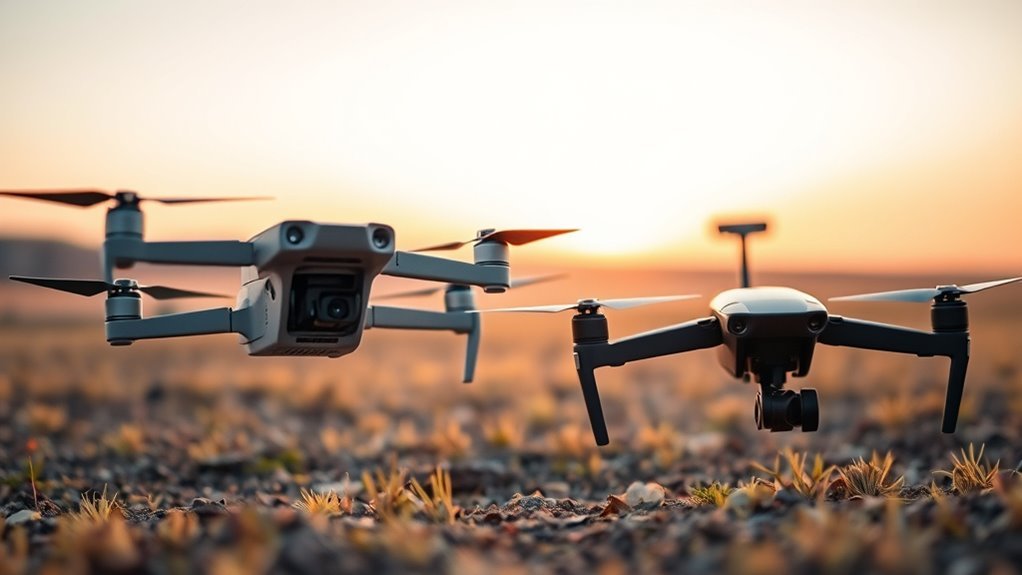As you compare the DJI Mini 3 Pro and Anzu Raptor T—both lightweight, NDAA-compliant drones—DJI’s OcuSync 3.0 delivers a 10km transmission range, outpacing Anzu’s 7km for superior signal resilience. The Mini 3 Pro’s foldable, under-250g design enhances portability, while Anzu’s rugged build guarantees durability. It also offers 34 minutes of flight time versus Anzu’s 25 minutes, optimizing efficiency. Additional insights on performance lie ahead.
Design and Build Features
While the DJI Mini 3 Pro emphasizes portability with its lightweight, foldable design weighing under 250 grams, the Anzu Raptor T prioritizes durability through reinforced materials and weather-resistant seals. You’ll notice the DJI Mini 3 Pro’s aesthetic appeal in its streamlined, compact form, allowing seamless storage and transport for spontaneous adventures. Its material quality features high-grade plastics that balance weight and strength, empowering you to capture freely without bulk.
In contrast, the Anzu Raptor T’s aesthetic appeal lies in its rugged, industrial look, designed for resilience in demanding conditions. Its superior material quality includes reinforced alloys and protective coatings, ensuring long-term reliability. This setup lets you operate with confidence, embracing freedom in diverse settings, from urban explorations to remote terrains. Ultimately, both drones offer choices that align with your desire for uninhibited mobility and enduring performance, tailored to enhance your aerial experiences. Additionally, the affordable pricing strategies employed by budget brands like Potensic highlight options for those seeking entry-level drones without financial strain.
Transmission and Range Performance
The DJI Mini 3 Pro’s transmission relies on OcuSync 3.0 technology, delivering up to 12 km of range with stable, low-latency video feeds that help you maintain control in various environments. This system excels in signal clarity, providing crisp, reliable visuals that let you explore freely without distortion. Its interference resistance is exceptional, using advanced algorithms to minimize disruptions from Wi-Fi or other signals, so you’re always in command during adventures.
In comparison, the Anzu Raptor T features a 7 km range with its transmission setup, which offers solid signal clarity for basic operations but falls short in interference resistance. You might notice more vulnerability in urban settings, potentially limiting your freedom to fly in crowded areas. Overall, the DJI’s superior range and resilience give you greater autonomy, making it ideal if you prioritize uninterrupted, long-distance control without compromises. Additionally, its AI-powered obstacle avoidance ensures safe navigation, enhancing operational efficiency during extended flights.
Battery Life and Flight Capabilities
Battery life plays an essential role in drone operations, with the DJI Mini 3 Pro delivering up to 34 minutes of flight time per charge, supported by efficient power management for stable, extended flights. You’ll appreciate its superior battery efficiency, which optimizes energy use for longer flight endurance, letting you explore vast areas without frequent interruptions.
In contrast, the Anzu Raptor T offers around 25 minutes of flight time, relying on solid but less advanced battery efficiency. This means you’ll face shorter flight endurance, potentially limiting your freedom to roam remote spots or capture extended footage. Both drones emphasize wind resistance and stable hovering, but the DJI’s edge in battery efficiency enhances your ability to push boundaries safely. Additionally, the transmission range of both drones is crucial, as the DJI Mini 3 Pro boasts a longer range for expansive aerial exploration. When choosing, consider how these factors align with your need for uninterrupted aerial adventures—DJI gives you more leeway for spontaneous creativity, while Anzu keeps things reliable yet restrained. Ultimately, it’s about maximizing your skyward independence.
Frequently Asked Questions
What Is the Price Difference Between These Drones?
You’re wondering about the price difference between these drones, aren’t you? Imagine you’re planning a cross-country adventure and need cost-effective choices. In a thorough price comparison, the DJI Mini 3 Pro typically costs around $709, while the Anzu Raptor T is about $499, offering solid budget options. This gap lets you select lightweight, NDAA-compliant models freely, empowering your aerial explorations without financial strain.
Are There Any Available Bundle Deals?
You’re wondering about available bundle deals for drones. Bundle options often include the drone with extras like additional batteries, propellers, and carrying cases, offering package savings that can cut costs by 15-25% compared to buying items separately. This lets you maximize your investment, giving you more freedom to explore aerial photography without the hassle of piecemeal purchases. Check retailers for current promotions to find the best deals tailored to your needs.
How Do I Update the Firmware on Each Drone?
To update your drone’s firmware, you’ll start with the firmware process by ensuring it’s powered on and connected to the right app. For the DJI Mini 3 Pro, use update methods in the DJI Fly app: download the latest firmware, follow on-screen prompts, and complete the install. For the Anzu Raptor T, access the Anzu app, check for updates, and apply them through its interface. This empowers you to maintain peak performance independently.
What Accessories Are Recommended for Beginners?
As you ease into the skies with your first flights, beginner accessories serve as your gentle guides to freedom. Essential gear includes extra batteries for extended aerial adventures, a protective carrying case for hassle-free transport, ND filters to refine your footage, and propeller guards for safe maneuvers. These technical tools empower you to explore confidently, enhancing your drone experiences without unnecessary complications. Remember, you’re building wings for limitless discovery.
Is There a Warranty Comparison for Both Models?
When you’re evaluating warranty comparisons for drone models, you’ll want to examine the warranty terms and coverage details first. One offers a standard 1-year warranty covering manufacturing defects, parts, and labor, while the other provides similar 1-year coverage with potential extensions for added protection. This knowledge empowers you to select freely, ensuring your aerial adventures remain unrestricted and worry-free.

